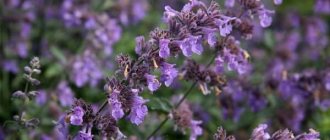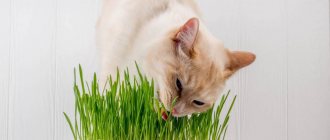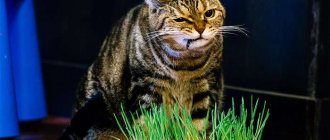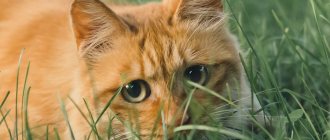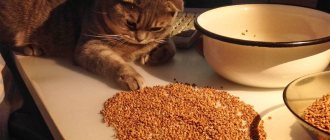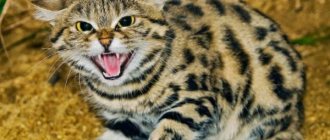Can cats have grass?
Is grass good for cats? Yes, but not all of it. There are certain plants (eg wheatgrass) that animals need. At the same time, leaves of the same type, growing close to each other, may or may not be suitable for cats. The pet will find the leaf itself by sniffing and eating the desired plant. If he doesn’t want to eat greens, it means he doesn’t need it, and there’s no need to force him. Can cats be given grass in this case? Leaves should not be forced into the throat.
Important: If your pet eats too many leaves or eats them every day, contact your veterinarian. Perhaps the animal has problems with the digestive system, vitamin deficiency.
Beneficial properties of different types of herbs
Not all greens are created equal. It is better to plant several species at once, and then the pet will be able to make a choice.
Here is the grass that cats prefer:
- Wheat. Young sprouts have a pleasant sweetish taste. Wheat greens are rich in fiber and omega-3s. It is unpretentious, grows quickly and requires minimal care.
- Oats. Another plant rich in fiber. Green oats contain fats, amino acids and antioxidants.
- Barley. These greens stimulate metabolism. It contains beta-glucan and folic acid.
- Thyme. This herb has a calming effect.
- Wheatgrass. These greens most effectively cleanse your pet's stomach of fur.
- Licorice. It has a healing effect, accelerates the healing of the gastric mucosa, stimulates the digestion and endocrine system.
Seeds for germination can be mixed, then cats will be able to independently choose what to chew on.
Reasons why cats eat grass
Do cats need grass? Definitely yes. Cats are treated with grass. The main reason why a cat eats leaves is to try to solve problems with the digestive tract. Wide grass is believed to have a laxative effect, while narrow grass helps relieve indigestion.
The cat eats plants with hard leaves to clear the stomach of undigested food debris (feathers, bones). They can get stuck in the gastrointestinal tract and cause serious complications. The cat also eats grass to rid the digestive tract of hair that it swallowed when licking its fur. The hard leaves, which the pet swallows to cleanse the stomach, irritate the mucous membrane of the organ, stimulating regurgitation.
It should be noted that a cat does not always regurgitate fur. The hairs often pass through the digestive system and are excreted in the feces. The fiber that your pet gets from eating grass helps the intestines push stool out.
Why grass is good for cats: other reasons
There are other reasons why your pet eats grass:
- Nutrients. The greens that your cat eats contain fiber and beneficial substances. True, the body does not take nutrients from every herb. For example, wheatgrass is in transit. If the cat does not regurgitate the leaves, they will be released in the feces through the intestines.
- Folic acid. Plants that pets love contain folic acid - vitamin B9. It has a positive effect on the growth of the body and increases the level of oxygen in the blood.
- Stress. A cat can eat cat grass at home when it is nervous or irritated. Eating greens helps you calm down.
- Fighting worms. It is believed that under the influence of hard leaves, the intestines work better, which helps get rid of helminths. The theory is controversial, since most of the worms remain. However, some scientists argue that this is how wild animals in ancient times got rid of helminths.
- I like the taste. Why does a cat need grass? Some pets eat plants simply because they like it.
Cats crave mint and valerian
The amazing affection of cats of all types and breeds for valerian and catnip has always attracted the attention of people. These completely different plants contain special pheromones, which attract both pets and wild predators. Such cat passion can turn out both to the benefit of animals and to their detriment.
Cat mint
The very name of catnip (or catnip) indicates the special attitude of cats to this inconspicuous perennial grass, which grows everywhere like a weed: in meadows and parks, wastelands and vegetable gardens.
Catnip grows up to a meter in height, has jagged leaves characteristic of all types of mint and modest inflorescences of various shades - white, pink, purple. The peak of flowering occurs in mid-summer - during this period the grass is harvested, if necessary.
Catnip is usually harvested during the flowering period
The organic compound nepetolactone is the main component of the essential oil, which determines the attractiveness of the plant to adult cats. Immature kittens are not interested in this natural pheromone, but sterilized animals react to it differently, but most often in the same way as before the operation. Older animals become indifferent to the delights of catnip.
It is curious that this passionate attachment is genetic in cats and cats and is inherited. That is why there are some adult individuals who do not react at all to the “magical” smell of catnip.
By influencing those areas of the brain that are responsible for the emotional sphere, nepetolactone causes mild, but very pleasant hallucinations for the animal - obviously of an erotic nature. Cats do not develop any addiction, much less dependence on this substance, so catnip can be considered a safe plant for them. But prolonged exposure to nepetolactone in especially emotional people can lead to overexcitation and even disorders of the nervous system.
The effect of this herbal aphrodisiac is short-lived and usually lasts no longer than a quarter of an hour. Then it will take at least forty minutes before the cat becomes receptive to it again.
For most cats, catnip evokes pleasant visions.
Catnip can be used either fresh or dried, or as infusions; Pet stores sell ready-made preparations based on the extract of this herb. The properties of catnip are used for various purposes:
- improve appetite;
- trained to use the tray;
- switch attention from scratching wallpaper and furniture to the scratching post;
- processing new toys.
Interestingly, catnip essential oil is hated by some household pests and unwanted insects:
- rats;
- mice;
- cockroaches;
- mosquitoes
By the way, valerian officinalis and drugs based on it have the same properties.
Video: What a cat is willing to do to get catnip
Valerian
Valerian officinalis is popularly called cat herb - almost all adult cats react violently to this plant. The effects of pungent valerian on cats are similar to the effects of catnip on them - but in this case you need to be more attentive and careful. An overdose of the enzyme actinidin contained in the herb and especially the roots of valerian can lead to undesirable consequences.
Valerian officinalis is a tall herbaceous plant with carved leaves and umbrella-shaped inflorescences.
This beautiful perennial plant reaches a height of one and a half meters. It blooms with spectacular white “umbrellas” almost throughout the warm season. All parts of the plant can be harvested, but its roots contain the highest concentration of active substances.
The plant substance is identical to one of the odorous components of cat urine and acts on adult cats as a powerful aphrodisiac, changing for a short time not only their emotional but also hormonal balance. This can pose a serious danger to the animal and cause the following unpleasant side effects:
- convulsions;
- strong secretion of saliva and foam from the mouth;
- clouding of consciousness;
- difficulty breathing, even stopping;
- stroke.
A cat that has tasted valerian or catnip may behave inappropriately
Actinidin has an exciting effect on cats - they behave as if they are in a state of drug intoxication and get great pleasure from it. But this creates a huge load on the nervous system, and if it is unstable, then you should not abuse valerian under any circumstances - it is definitely not fun.
Don't give valerian to your cat just for fun.
The valerian plant is unlikely to cause harm to your pet, but medications that contain concentrated actinidin can become a source of danger for the cat. There are strict contraindications for the use of alcoholic extracts of valerian:
- increased excitability;
- kidney and liver pathologies;
- periods of pregnancy and lactation.
Valerian is dangerous for a pregnant cat
But valerian in moderate doses is very useful for digestion. The fact is that this herbal medicine also has the property of relaxing smooth muscles, which helps relieve spasms and colic in the gastrointestinal tract. Veterinarians also prescribe valerian preparations in the complex treatment of cardiovascular diseases and thyroid problems. You must strictly adhere to the doctor's recommendations and dosage of medications.
Scientists studying the life of wild cats in nature often use valerian tincture to lure the animals closer.
Some other plants can have an effect similar to valerian and catnip on representatives of the cat family:
- peppermint;
- thyme;
- lemongrass;
- Melissa;
- honeysuckle.
Video: cat eats dried valerian
What grass can you give to cats?
In addition to wheatgrass, cats also benefit from parsley, thyme, and rosemary. They can eat sprouted oats, barley, and wheat. What grass do cats need? They love catnip, which you can grow right on your windowsill.
If you find out what kind of grass cats like and grow catnip, be careful. It can be used to accustom a cat to a scratching post, attract attention to the toy, and relieve stress. Don't just give catnip. It is especially contraindicated for easily excitable and pregnant pets.
Medicinal herbs in finished animal feed
You can also find medicinal herbs in prepared diets for pets. As a rule, this inspires great confidence among many owners. After all, the use of natural ingredients involuntarily suggests that all other components of the food will be no less high-quality and healthy. Is it really?
Let's start with the fact that after undergoing heat treatment, medicinal herbs will probably lose some of their beneficial properties. Accordingly, there should not be so few of them. In addition, if the list of ingredients contains the wording “medicinal herbs” without deciphering the contents, then it is difficult to believe in the great natural healing power of such a component. One good thing is that such an ingredient will not harm your pet. It’s another matter if the food contains full information about the medicinal herbs it contains. It is ideal if the method of their use is indicated - drying or extract, as well as the quantity.
Among the ingredients, medicinal herbs may be designated by other names. For example, a herbal or plant complex, a mixture of herbs or herbs, herbs, dried herbs, etc.
What foods contain the ingredient “medicinal herbs”
| name of food | for dogs | for cats |
| Acana | fresh cranberries, fresh blueberries, chicory root, turmeric, milk thistle, burdock root, lavender flowers, marshmallow root, rose hips | fresh cranberries, fresh blueberries, chicory root, turmeric, milk thistle, burdock root, lavender, marshmallow root, rosemary |
| Orijen | cranberries, blueberries, serviceberry berries, chicory root, turmeric root, milk thistle, burdock root, lavender, marshmallow root, rose hips | whole cranberries, whole blueberries, whole serviceberry berries, chicory root, turmeric, milk thistle, burdock root, lavender flowers, marshmallow root, rose hips |
| Satisfaction | aromatic herbs (basil, rosemary, agrimony) | — |
| Brit Premium | herbs and fruits (cloves, citrus fruits, rosemary, turmeric, 120 mg/kg), dried chamomile (80 mg/kg), blueberry (50 mg/kg) | plant extract: rosemary, cloves, citrus fruits, turmeric (55 mg/kg) |
| Belcando | herbs (total 0.2%: nettle leaves, gentian root, centaury, chamomile, fennel, caraway, mistletoe, yarrow, blackberry leaves) | — |
| Profine | mixture of herbs (fennel, basil, sage 0.02%) | — |
| Carnilove | thyme (0.01%), rosemary (0.01%), oregano (0.01%), cranberry (0.0008%), blueberry (0.0008%), raspberry (0.0008%) | plantain (0.01%), thyme (0.01%), rosemary (0.01%), oregano (0.01%), cranberry (0.0008%), blueberry (0.0008%), raspberry (0.0008%) |
| Optimal | marigold (source of lutein) - 0.04%, burdock root, marshmallow root, chamomile flowers - 0.03%, nettle - 0.03%, thyme - 0.015% | 0.04%, marigold (source of lutein) 0.04%, burdock root, marshmallow root, chamomile flowers 0.03%, nettle 0.03%, thyme 0.015% |
| Pronature Holistic | — | spice mixture (0.02%, dried rosemary, dried parsley, dried mint leaves, turmeric) |
Medicinal herbs are certainly beneficial for the health of pets. However, you need to approach the use of such a delicate component wisely. Especially in cases of their independent introduction into the diet. Study literature and food in detail, consult with specialists. And, of course, with veterinarians regarding the use of herbal medicine. Let your beloved pets be healthy and full of strength for many happy years!
What plants are dangerous for cats?
If there is a cat at home, get rid of flowers that he could at least potentially eat:
- geraniums;
- lilies;
- aloe;
- amaryllis;
- Dieffenbachia;
- sago palm;
- violets;
- mint;
- lemon balm;
- calendula;
- lily of the valley;
- chrysanthemums.
The list of flowers dangerous for cats is long. Before you plant a new plant on the windowsill or in the garden, find out whether it will harm your pet. Do the same if there are already flowers on the windowsill when the kitten appears.
A cat is unlikely to eat toxic greens, but this possibility cannot be ruled out. The result can be tragic - from stomach bleeding to death.
At what age can it be given?
According to veterinarians' recommendations, a cat can start eating grass from 4 months of age. You need to gradually add a special herb purchased from a pet store to your baby’s diet. You can also purchase plant seeds in specialized stores. The body must gradually get used to the new food. Cats do not eat all plants; they prefer cereal grasses, such as sedge.
In pet stores you can purchase special dry food that helps remove hairballs, intended for ages from 1 to 10 years. You can also buy malt - a paste to add to the food of a pet that eats wet food and natural food. This paste should be used with caution, according to the instructions, in order to avoid the formation of intestinal blockages from hairballs.
How to plant grass for a cat in an apartment
To plant environmentally friendly greens that are healthy for your pet, you need to buy:
- light soil for flowers;
- container for planting, even a soup bowl will do;
- polyethylene film to create a greenhouse effect.
How to grow greens
- Wash the seeds and leave to soak for 1 hour.
- Pour soil into the container.
- Scatter the seeds evenly.
- Sprinkle the grains with soil.
- Water it.
- Stretch the film over the container to create a greenhouse effect, and the grains will germinate faster.
How to grow greens in gauze
If there is no soil, grass can be grown directly... in gauze. Do it like this:
- Rinse and leave the seeds to soak in cool water.
- Pour out the water and place gauze on the bottom of the container.
- Sprinkle the grains evenly onto the cloth.
- Cover the seeds with another piece of gauze.
- Pour water into a spray bottle and spray.
- Place film over the container.
After landing
Place the dishes in a warm place (in winter - on the radiator). When the seeds germinate (on 2-3 days), do not remove the film. The grass will be ripe for consumption in a week. Remove the oilcloth and show the cat the greens.
How much grass to give to a cat
How to feed a cat grass? Just show her a container of greens. Then the pet will figure it out on its own, including determining how much grass it needs. When your cat starts eating the leaves, he may vomit.
Don't punish your pet for burping, it's not on purpose. It’s better to buy hygiene products for cats, and place the container away from carpeting and upholstered furniture.
Rules for successfully growing weed for cats
Each growing kit comes with instructions to help you grow lush greens for your pet.
However, there are general rules that will help you avoid mistakes:
- Water the seeds daily, but the soil or substrate should not be too wet. The preferred watering option is spraying with a spray bottle.
- The best place for the container is a windowsill (in warmer months) or a table in a well-lit room. In winter, you should not send a jar of grass to the window, as the tender sprouts may freeze. If you place the tray next to the radiator, this will quickly dry out the substrate or other filler, and the grass will not sprout.
- You cannot cover the seeds with a thick layer of soil; the optimal thickness is 0.5-1 cm.
- A lack of light will cause the greenery to become stunted.
- You can speed up the growing process. To do this, the seeds are soaked in warm water for a couple of hours and then planted in the prepared substrate.
Grass from a container is an excellent replacement for outdoor greenery. It is not contaminated with parasite eggs and is not polluted by exhaust gases from cars. This grass will bring a lot of benefits to your pet, especially in winter.
Cat mint
It has long been noticed that cats are partial to a variety of mint, which was nicknamed lemon catnip (or mint). Cats really love to chew and smell this plant, because it has a strange effect on them: some pets calm down, others, on the contrary, become active.
Catnip is added to many pet toys to make them attractive to cats.
Attention! With the help of this plant you can accustom your pet to his house. All you have to do is put dried grass inside, and your cat will be happy to be there.
